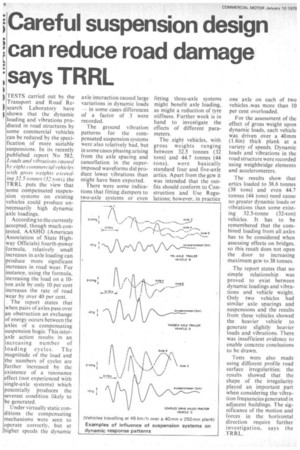Careful suspension design can reduce road damage says TRRL
Page 18

If you've noticed an error in this article please click here to report it so we can fix it.
TESTS carried out by the Transport and Road Research Laboratory have shown that the dynamic loading and vibrations produced in road structures by some commercial vehicles can be reduced by the specification of more suitable suspensions. In its recently published report No 582, Loads and vibrations caused by eight commercial %,ehicles with gross weights exceeding 32.5 tonnes (32 tons), the TRRL puts the view that some compensated suspension systems on existing vehicles could produce unnecessarily high dynamic axle loadings.
According to the currently accepted, though much contested, AASHO (American Association of State Highway Officials) fourth-power formula, relatively small increases in axle loading can produce more significant increases in road wear. For instance, using the formula, increasing the load on a 10ton axle by only 10 per cent increases the rate of road Wear by over 40 per cent.
The report states that when pairs of axles pass over an obstruction an exchange of energy occurs between the axles of a compensating suspension bogie. This interaxle action results in an increasing number of loading cycles. The magnitude of the load and the numbers of cycles are further increased by the existence of a resonance effect (not experienced with single-axle systems) which potentially produces the severest condition likely to be generated.
Under virtually static conditions the compensating mechanisms were seen to operate correctly, but at higher speeds the dynamic axle interaction caused large variations in dynamic loads — in some cases differences of a factor of 3 were recorded.
The ground vibration patterns for the compensated suspension systems were also relatively bad, but in some cases phasing arising from the axle spacing and cancellation in the superimposed waveforms did produce lower vibrations than might have been expected.
There were some indications that fitting dampers to two-axle systems or even fitting three-axle systems might benefit axle loading, as might a reduction of tyre stiffness. Further work is in hand to investigate the effects of different parameters.
The eight vehicles, with gross weights ranging between 32.5 tonnes (32 tons) and 44.7 tonnes (44 tons), were basically standard four and five-axle artics. Apart from the gcw it was intended that the outfits should conform to Construction and Use Regulations; however, in practice one axle on each of two vehicles was more than 10 per cent overloaded.
For the assessment of the effect of gross weight upon dynamic loads, each vehicle was driven over a 40mm (1.6in) thick plank at a variety of speeds. Dynamic loads and vibrations in the road structure were recorded using weighbridge elements and accelerometers.
The results show that artics loaded to 38.6 tonnes (38 tons) and even 44.7 tonnes (44 tons) need cause no greater dynamic loads or vibrations than some existing 32,5-tonne (32-ton) vehicles, it has to be remembered that the combined loading from all axles has to be considered when assessing effects on bridges, so this result does not open the door to increasing maximum gcw to 38 tonnes.
The report states that no simple relationship . was proved to exist between dynamic loadings and vibrations and vehicle weight. Only two vehicles had similar axle • spacings and suspensions and the results from these vehicles showed the heavier vehicle to generate slightly heavier loads and vibrations. There was insufficient evidence to enable concrete conclusions to be drawn.
Tests were also made using different profile road surface irregularities; the results showed that the shape of the irregularity played an important part when considering the vibration frequencies generated in adjacent buildings. The significance of the motion and forces in the horizontal , direction require further investigation, says the TRRL.




































































































